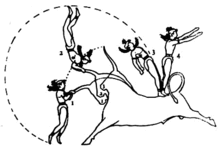Bull leap

A bull leap is an acrobatic exercise reconstructed from illustrations, presumably of a cultic character of the Minoan culture.
In bull jumping, young men and women jumped lengthways over a bull .
technology
According to the controversial reconstruction drawing by Arthur Evans , the jumper first caught a galloping wild bull by the left horn. The head movement of the bull threw the jumper into the air. With a somersault backwards, he jumped on the back of the bull, from where he jumped out over the tail of the bull and was caught.
This artistic exercise was life-threatening. If a jumper missed the bull's neck, he would be impaled and pierced by the bull, as shown by illustrations on Cretan stamp seals . It was initially unclear whether such exercises actually took place. For a long time it was not possible to replicate the technology . In 2010, Stuhlfauth made the connection to the bull jumps of the recortadores in Portugal and Spain, which show both the typical gestures with the raised arms and the somersaults along the back of the bull. The characteristic evasive movement of the recortadores in front of the bull's horns , emphasizing the hollow cross , can also be found in the Minoan bronze figure of Tylissos.
Place of execution
Evans assumed that the bull jump took place in a wooden palisade east of the Palace of Knossos. Ward argues in favor of locating the venue in the palace's central courtyard.
Chronology and Distribution
The first pictorial evidence of the bull leaping can be found in the early Minoan period (FM II, 2700–2150 BC) from Koumatsa and Porti . According to this, documents are only documented from the time of the new palaces (MM IIIb, SM IA), mainly from Knossos . The best-known example is the bull-jumper fresco from Knossos (see above). Kathryn Soar assumes that the Knossischen elites consciously took up or revived this old ritual in an urban context and used it in the context of competition between different factions.
A fresco from Tell el-Dab'a ( Auaris ) in Egypt and Syrian cylinder seals are among the few representations of the practice outside of Knossos and Crete. The reference to a wall painting in the palace of Tiryns , on which, according to Heinrich Schliemann, a man is shown dancing on a bull, is unclear .
Ward sees in the Theseus myth a final afterlife of this ritual. Stuhlfauth, on the other hand, considers a tradition with the public performances of the recontadores, which continues to this day, to be entirely possible due to the wide spread of the bull cult in the Mediterranean region.
- Representations of bull jumpers
- Illustration of a bull knight on a Minoan seal
- Ivory statuette - part of a multi-figure group from Knossos
literature
- M. Bietak et al .: The maze tableau from Tel et Dab'a. In: S. Sherrat (Ed.): The wall paintings of Thera. Athens 2000, pp. 77-90.
- MC Shaw: Bull leaping frescos at Knosos and their influence on the Tel el-Dab'a murals. In: M. Bietak (ed.): Trade, power and cultural exchange: Hyksos Egypt and the Eastern Mediterranean World 1800–1500 BC. Vienna 2995, pp. 91-120.
- Anne Ward : The Cretan bull sports. In: Antiquity. Volume 42, 1968, pp. 117-122.
- Adolf Metzner: You jumped for your life . In: Die Zeit , No. 18/1967
- Diamantis Panagiotopoulos : The Minoan bull jumping. For the performance and representation of an ancient Aegean ritual . In: Joannis Mylonopoulos, Hubert Roeder (Ed.): Archeology and Ritual. In search of the ritual act in the ancient cultures of Egypt and Greece . Phoibos, Vienna 2006, ISBN 3-901232-68-0 , p. 125-138 ( PDF, 8237.17 KB ).
- Dietmar Winkler: The Cretan bull jumping . In: Ernst Günther, Heinz P. Hofmann, Walter Rösler (eds.): Cassette. An almanac for the stage, podium and ring (= cassette ). No. 6 . Henschelverlag Art and Society, Berlin 1982, p. 158-160 .
Web links
- Reconstruction of the Minoan bull jump by Arthur Evans
- Late Minoan funnel rhyton with a bull jumping scene
- Example for the bull leaping of the Recortadores, Stuhlfauth, personal communication Frankfurt 2010
- Marie Brennan: Bull Leaping in Bronze Age Crete. www.strangehorizons.com, January 24, 2005, accessed March 16, 2012 .
- Figure of Tylissos from Some unpublished Studies by Paul Rehak on gender in Aegean Art . kuscholarworks.ku.edu (PDF; 610 kB)
Individual evidence
- ↑ S. Daminai-Indelicato: Were Cretan girls playing at bull-leaping? In: Cretan Studies. Volume 1, 1988, pp. 39-47
- ^ Stylianos Alexiou: Minoan Civilization. Translated from Greek into English by Cressida Ridley. Fourth edition. V. Manouras Co, Heraklion, plate 11
- ^ Journal of Hellenic Studies . Volume 41, 1921, pp. 247-259
- ^ Anne Ward: The Cretan bull sports. In: Antiquity. Volume 42, 1968, p. 117
- ↑ Kathryn Soar: Old Bulls, new tricks: the reinvention of a Minoan Tradition. In: M. Georgiades, Chr. Gallou (ed.): The Past in the past: The significance of memory and tradition in the transmission of culture. BAR International, 1925, 2009, pp. 22-24
- ↑ Kathryn Soar: Old Bulls, new tricks: the reinvention of a Minoan Tradition. In: M. Georgiades, Chr. Gallou (ed.): The Past in the past: The significance of memory and tradition in the transmission of culture. BAR International, 1925, 2009, p. 17
- ^ Anne Ward: The Cretan bull sports. In: Antiquity. Volume 42, 1968, p. 122
- ↑ Dr. Thomas Stuhlfauth, personal communication, Frankfurt 2010




